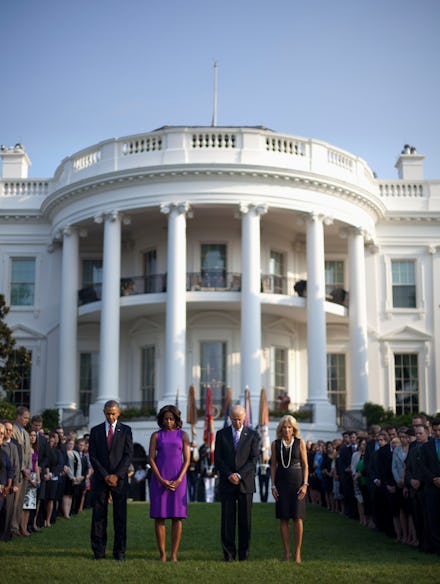A Brief History of the Moment of Silence

Thursday marks the 13th anniversary of 9/11, and as the nation prepares for a day of solemn reflection and remembrance, we pay tribute to the fallen with moments of silence.
Throughout the morning, Americans observe a moment of silence at six different times:
1) 8:46 a.m. EDT: when American Airlines Flight 11 hit the north tower at the World Trade Center
2) 9:03 a.m. EDT: when United Airlines Flight 175 hit the south tower at the World Trade Center
3) 9:37 a.m. EDT: when American Airlines Flight 77 crashed into the Pentagon
4) 9:59 a.m. EDT: when the south tower at World Trade Center fell
5) 10:03 a.m. EDT: when United Airlines Flight 93 crashed near Shanksville, Pa.
6) 10:28 a.m. EDT: when the north tower at World Trade Center fell
"America will never forget the September tragedy that shook our Nation's core 13 years ago. On a day that began like so many others, a clear blue sky was pierced by billowing black smoke as a wave of grief crashed over us," announced President Obama in his annual reaffirmation of the Patriot Day and National Day of Service and Remembrance.
"But in one of our darkest moments, we summoned strength and courage, and out of horrible devastation emerged the best of our humanity. On this solemn anniversary, we pause in remembrance, in reflection, and once again in unity."
Where does the moment of silence come from? While it feels like holding a moment of silence is an age-old practice, there are several ideas as to where it originally comes from. Traditionally, observing silent prayer or worship has been a Quaker practice for around 350 years, and the silence is shared as "a communal experience, yet a communality quite distinct from the silent meditation of other traditions, even when practiced in a group, because the silence is alive with the possibility of prophecy."
But there are two prevailing theories as to how holding a moment of silence became a common, secular practice to honor the dead. The first comes from Cape Town, South Africa, where World War I fighting between British and German forces was reportedly commemorated every day through a brief moment of silence until the Armistice Day. A Reuters correspondent then wrote about the practice, popularizing it throughout the Commonwealth.
The second theory is that the tradition was proposed by Australian journalist Edward George Honey, who wrote a letter to the London Evening News in 1919, suggesting that the anniversary of the armistice that ended World War I on Nov. 11, 1918 should be greeted with a moment of silence. "Five little minutes only," he wrote. "Five silent minutes of national remembrance."
In both cases, politician Sir Percy Fitzpatrick brought the idea to King George V's attention, and on Nov. 17, 1919, it became official.
"On the 11th hour of the 11th day of the 11th month, there may be for the brief space of two minutes a complete suspension of all our normal activities. ... So that in perfect stillness, the thoughts of everyone may be concentrated on reverent remembrance of the glorious dead," the king proclaimed.
The rest is history. No matter what the actual origin may be, moments of silence have been used to unite people in communal reflection and mourning and in appreciation and gratitude for the service given by those who have fallen. And as we commemorate 9/11, let us use these moments of silence to become the "best of our humanity," as Obama pointed out, so that we can properly honor and pay tribute to these people's legacy.